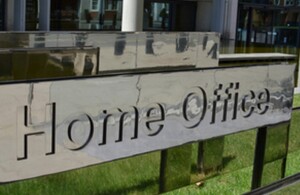New passport design hits the streets
The first new look UK passport was issued today to five-year-old Elliot Coutts Miller.

Elliot, who attends Shortwood Infant School, Staines in Surrey, received his passport at the London passport office based in Globe House in Victoria.
The new passport, which was unveiled in August, contains a number of enhanced security features to keep fraudsters at bay ensuring that the British passport remains a highly trusted document.
From December 2010 the majority of applicants applying for a passport should receive the new design, which will be phased in gradually from this month, with all applicants receiving the new version from October next year.
Home Office minister’s statement
Immigration Minister Damian Green said:
‘I am delighted Elliot is the first person to receive this new passport which has been redesigned to ensure it remains as secure a document as ever.
‘The passport contains strengthened security measures, which includes designs of iconic images from across the nation, making the passport difficult to forge and helping ensure the British passport remains a highly trusted passport meeting rigorous international standards.’
Elliot’s statement
Elliot, from Stanwell Moor near Heathrow, received his passport in preparation for a family holiday and was given permission from his headmistress to take time off to receive his passport in person.
Elliot Coutts Miller, commenting on the day said:
‘I am very excited with my new passport. I like the pictures especially the butterfly.’
More about the new passports
The new passport’s pages contain images of well-known UK scenes, including the White Cliffs of Dover, the Gower Peninsula, Ben Nevis and the Giant’s Causeway.
The new design, which will continue to contain a chip holding the owners details, will replace the current UK ePassport introduced in 2006 to comply with the US Visa Waiver Programme.
Notes to editors
The new passport contains a number of security features.
These include:
- the movement of the chip which stores the holder’s details to the inside of the passport cover where it will no longer be visible. This gives additional physical protection as well as making it much harder to replace the chip without damage to the passport cover being spotted
- a secondary image of the holder printed onto the observations page;
new designs now stretching across two pages - a new transparent covering which includes several holograms to protect the holder’s personal details
De La Rue took over the contract for passport production in October 2010 when the previous contract expired. The value of the ten-year contract is £400 million, representing value for money for the taxpayer by providing an upgraded product for less than the previous contract.
The personal details page of the passport has been moved to the front of the book, in common with many European countries and New Zealand, USA, Australia, Canada, Russia, Japan, Pakistan, Republic of Korea (south) and Liberia.
Since then, 15 different versions of the passport have been issued. Find out more about the history of the passport.
The electronic passport or ePassport was launched in 2006 and featured a microchip and facial biometrics. There are now around 25 million ePassports in use.
During the last financial year (09/10) the Identity and Passport Service issued 5.35 million passports.
An adult passport costs £77.50 for standard service and £112.50 for the one week Fast Track service. A child passport costs £49 for standard service and £96.50 for the one-week Fast Track service.
Images of the new passport design are available on request from the Home Office press office on 020 7035 3535.